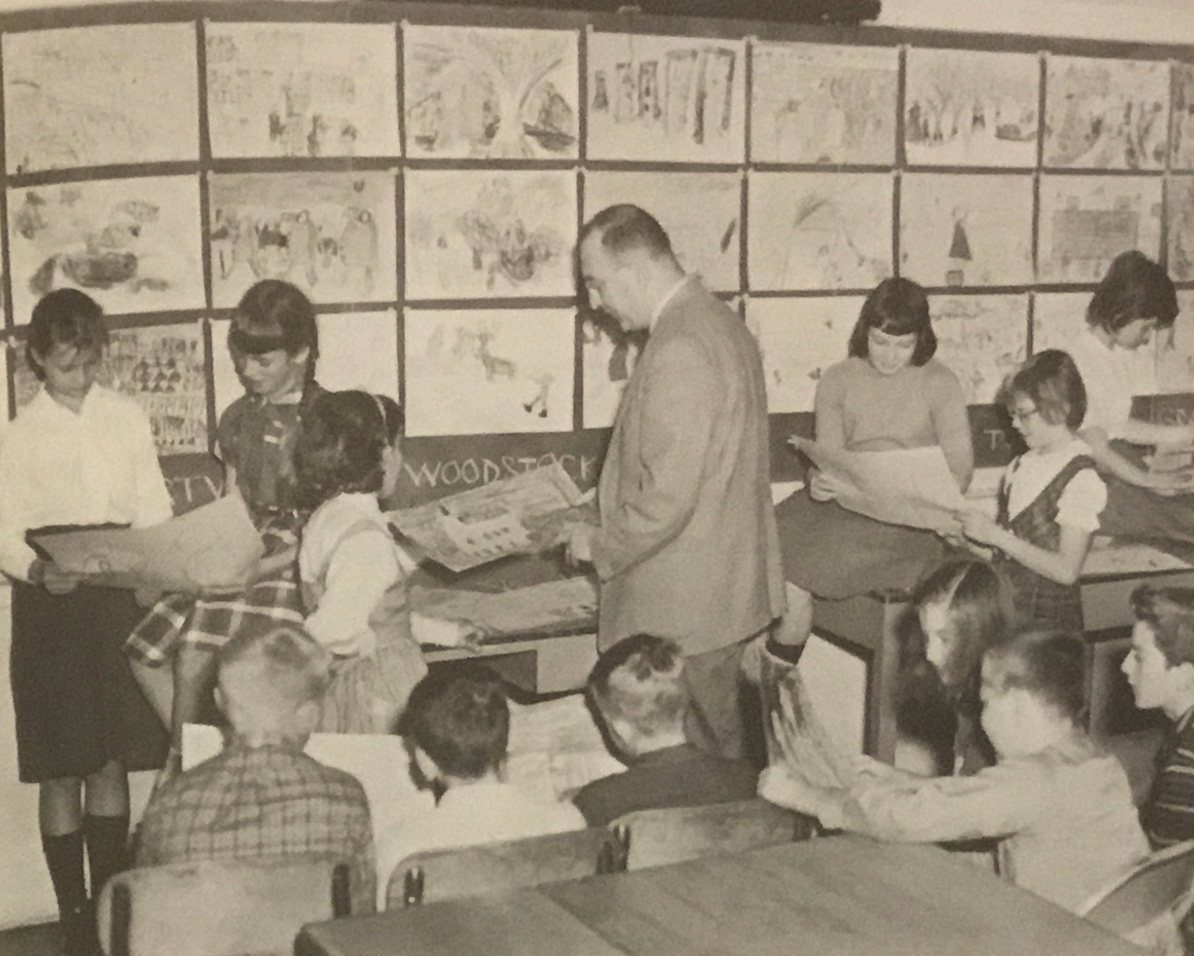Francis Gyra: Artist and Teacher
By Jennie Shurtleff
Woodstock has been home to many outstanding artists and teachers over the years. Francis Gyra, better known as Frank, was both. For countless students who attended Woodstock schools, Mr. Gyra was their first exposure to the world of art, and he took that responsibility seriously.
He came to the Woodstock area in the late 1940s. At that time, both Woodstock’s high school and elementary school were located where the elementary school now stands. Mr. Gyra was given the old “gum-wrapper strewn” assembly hall as his room. Gyra was undaunted. According to a Vermont Standard article published on September 29, 1949, he went to work, patching walls and then painting them with an aesthetically pleasing combination of coral and green. Since he didn’t have a movie screen, on the main wall he painted a large white square on which he could project slides and movies. A blackboard was located to one side, on which he would write the key points that he wanted to ensure that students took away from his lectures. On another wall he painted blocks of different shapes on which he had the seventh and eighth grades cooperatively paint murals.
The effort that Mr. Gyra expended in setting up the art room was an indication of the effort that he later put forth in teaching. In Mr. Gyra’s own words, his goal was to provide an educational experience in which “lectures, practical application of problems, and changing exhibitions are given to arouse enthusiasm. Direct effort is made to guide self-expression into the proper channels so that discipline will not be excluded – for it, above all, is the basis of character, in Art or any other field of endeavor. The main effort is to enrich the lives of our students by contact with the results of the past and to inspire an approach to logical thinking which comes from a proper development of Art – which in turn will be reflected in their other studies and their lives ahead of them.”
Creating a beautiful masterpiece, while rewarding, was not the only desired outcome. Of equal, or perhaps more importance, was what one learned from doing that piece of art and an understanding that beauty often transcends traditional definitions. As Gyra expressed it, there is “as much beauty in a slag tip as a crystal chandelier” if both were evaluated in relation to their “own dignity and background.”
In Mr. Gyra’s classes, students not only created art, but they also looked at each other’s creations to see what they could learn their peers. Ken Miner photo.
Mr. Gyra lectured widely about the importance of education in general and art in particular. In 1955, Mr. Gyra was the guest speaker at a school meeting in which he discussed the development of artistic abilities in elementary and high school students and explained how the various projects he assigned helped to support the development of the skills and abilities. At that meeting, he had five of his students - Robert Hager, Linna Kendall, Ethel Smith, Barbara Patenaude, and Jane Pinney – at the meeting to show their work and comment on what they had learned from the projects.
As a former Woodstock elementary school student who was fortunate enough to have Mr. Gyra as a teacher, the activity that I remember the most clearly is the yearly art sheet. This sheet had about twelve empty boxes on it. Each box was for a different type of assigned drawing, such as a self-portrait, which we were given a limited amount of time to complete. By comparing the current year to the previous years, one could see how our creativity and artistic skills were progressing and how we were able to integrate the new things that we were learning into our artwork. While I never realized what Mr. Gyra’s loftier, grander intentions were from such assignments, I learned to love art.
For those who showed an interest in art, Mr. Gyra offered a free, after-school art club. One of the projects for this art club was creating a tactile collage out of pieces of embossed wallpaper. The goal of this project was to encourage the development of the sense of touch by allowing the tactile nature of the artwork to suggest imagery either by recall or through the spontaneous tactile experience. After completing our collages, we took them over to the Homestead to share them with the residents who were visually impaired, in hopes of allowing them to experience the art. The assignment was classic Mr. Gyra – thoroughly thought out with layered, nuanced learning experiences that went well beyond pieces of textured paper neatly glued to a piece of cardboard.
While Mr. Gyra is perhaps best known locally for his many years as an art instructor, he was also a noted artist. During his long career, his work was exhibited at the Chicago Art Institute, Pennsylvania Academy of the Fine Arts, Minneapolis Institute of Art, Toledo Museum of Art, Milwaukee Art Institute, Memorial Art Gallery, Carnegie Institute, Philadelphia Art Alliance, Providence Art Museum, Rundell Gallery, Chaffee Art Museum, Rutland, Vermont, among others. In addition, his work is represented in collections at Providence Art Museum, Vanderbilt University, the Nashville Municipal Gallery, and now, thanks to Tuesday and Dennis Wright, the Woodstock History Center. This past summer, the Wrights donated two paintings. The Woodstock History Center plans to feature these two paintings in an upcoming Art Share exhibit in 2022.
One of the Frank Gyra paintings donated by Tuesday and Dennis Wright. © Woodstock History Center


